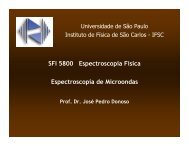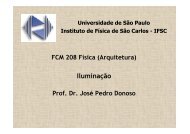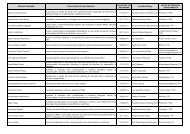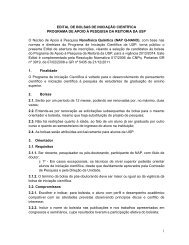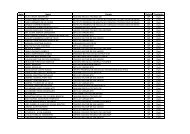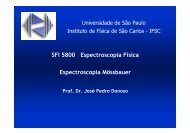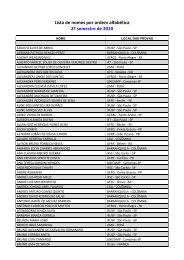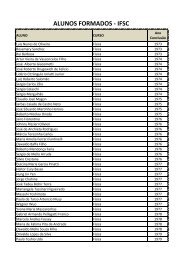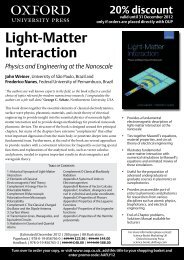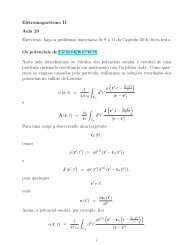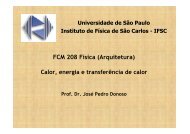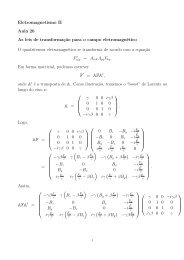Strong coupling and strange quark mass from lattice ... - IFSC - USP
Strong coupling and strange quark mass from lattice ... - IFSC - USP
Strong coupling and strange quark mass from lattice ... - IFSC - USP
You also want an ePaper? Increase the reach of your titles
YUMPU automatically turns print PDFs into web optimized ePapers that Google loves.
<strong>Strong</strong> <strong>coupling</strong> <strong>and</strong> <strong>strange</strong> <strong>quark</strong> <strong>mass</strong> <strong>from</strong><br />
<strong>lattice</strong> QCD<br />
Rainer Sommer<br />
<strong>IFSC</strong> – <strong>USP</strong>, Sao Carlos, April 3, 2013<br />
Rainer Sommer<br />
<strong>Strong</strong> <strong>coupling</strong> <strong>and</strong> <strong>strange</strong> <strong>quark</strong> <strong>mass</strong> <strong>from</strong> <strong>lattice</strong> QCD
The talk is based on<br />
◮ old work [<br />
LPHA ACollaboration ]<br />
◮ N f = 2 running<br />
[Nucl.Phys. B713 (2005) 378, Michele Della Morte, Roberto Frezzotti, Jochen Heitger, Juri Rolf, RS, Ulli<br />
Wolff ]<br />
[Nucl.Phys. B729 (2005) 117, Michele Della Morte, Rol<strong>and</strong> Hoffmann, Francesco Knechtli, Juri Rolf, RS,<br />
Ines Wetzorke, Ulli Wolff ]<br />
◮ Scale setting<br />
[Strange <strong>quark</strong> <strong>mass</strong> <strong>and</strong> the Lambda parameter in two flavor QCD,<br />
Fritzsch, Leder, Knechtli, Marinkovic, Schaefer, S, Virotta, 2012 ]<br />
◮ Recent development<br />
[Fritzsch & Ramos, arXiv:1301.4388 ]<br />
Rainer Sommer<br />
<strong>Strong</strong> <strong>coupling</strong> <strong>and</strong> <strong>strange</strong> <strong>quark</strong> <strong>mass</strong> <strong>from</strong> <strong>lattice</strong> QCD
Fascinating strong interactions<br />
◮ jets at large energies<br />
◮ hadrons at small energies<br />
◮ nuclei at even smaller energies<br />
Rainer Sommer<br />
<strong>Strong</strong> <strong>coupling</strong> <strong>and</strong> <strong>strange</strong> <strong>quark</strong> <strong>mass</strong> <strong>from</strong> <strong>lattice</strong> QCD
Fascinating strong interactions<br />
THEORY<br />
◮ jets at large energies<br />
Q C D<br />
◮ hadrons at small energies<br />
Q C D<br />
◮ nuclei at even smaller energies<br />
Q C D<br />
Believed to be described by a most beautiful theory: Q C D<br />
Rainer Sommer<br />
<strong>Strong</strong> <strong>coupling</strong> <strong>and</strong> <strong>strange</strong> <strong>quark</strong> <strong>mass</strong> <strong>from</strong> <strong>lattice</strong> QCD
QCD<br />
L QCD = − 1<br />
2g 0<br />
2 tr{F µνF µν } +<br />
◮ N f + 1 = 7 (bare) parameters<br />
N f<br />
∑<br />
ψ f {D + m 0f }ψ f<br />
f =1<br />
◮ at low energy essentially 4 parameters<br />
◮ in the following: u, d <strong>quark</strong>s <strong>mass</strong>-degenerate<br />
s-<strong>quark</strong> quenched<br />
3 parameters<br />
Rainer Sommer<br />
<strong>Strong</strong> <strong>coupling</strong> <strong>and</strong> <strong>strange</strong> <strong>quark</strong> <strong>mass</strong> <strong>from</strong> <strong>lattice</strong> QCD
. .<br />
<strong>Strong</strong> force<br />
A way to define the strong force is<br />
x<br />
y<br />
F (r) = d dr V (r) , r = |x − y| Q _ Q<br />
Perturbation theory (Feynman graphs)<br />
F (r) = 4 1<br />
3 4πr 2 g 2 + O(g 4 )<br />
coulombic<br />
Rainer Sommer<br />
<strong>Strong</strong> <strong>coupling</strong> <strong>and</strong> <strong>strange</strong> <strong>quark</strong> <strong>mass</strong> <strong>from</strong> <strong>lattice</strong> QCD
. .<br />
<strong>Strong</strong> force<br />
A way to define the strong force is<br />
x<br />
y<br />
F (r) = d dr V (r) , r = |x − y| Q _ Q<br />
Perturbation theory (Feynman graphs)<br />
F (r) = 4 1<br />
3 4πr 2 g 2 + O(g 4 )<br />
↓<br />
r 2 0 F (r)<br />
coulombic<br />
r/r 0<br />
Rainer Sommer<br />
[r 0 ≈ 0.5 fm]<br />
<strong>Strong</strong> <strong>coupling</strong> <strong>and</strong> <strong>strange</strong> <strong>quark</strong> <strong>mass</strong> <strong>from</strong> <strong>lattice</strong> QCD
<strong>Strong</strong> <strong>coupling</strong><br />
Perturbation theory (Feynman graphs)<br />
F (r) = 4 1<br />
3 4πr 2 g 2 + O(g 4 )<br />
coulombic<br />
Rainer Sommer<br />
<strong>Strong</strong> <strong>coupling</strong> <strong>and</strong> <strong>strange</strong> <strong>quark</strong> <strong>mass</strong> <strong>from</strong> <strong>lattice</strong> QCD
1.2<br />
1<br />
0.8<br />
0.6<br />
0.4<br />
0.2<br />
r/r0<br />
<strong>Strong</strong> <strong>coupling</strong><br />
Perturbation theory (Feynman graphs)<br />
F (r) = 4 1<br />
3 4πr 2 g 2 + O(g 4 )<br />
A way to define the strong <strong>coupling</strong> is<br />
coulombic<br />
α qq (µ) = ḡ 2 qq(r)<br />
4π<br />
It is r-dependent: “it runs”<br />
≡ 3 4 r 2 F (r) , µ ≡ 1/r<br />
αqq(r) = r 2 F (r)/CF<br />
β = 5.3, κ = 0.13638<br />
β = 5.5, κ = 0.13671<br />
3-loop Nf = 2<br />
4-loop Nf = 2<br />
Nf = 0, continuum<br />
3-loop Nf = 0<br />
4-loop Nf = 0<br />
0<br />
0 0.1 0.2 0.3 0.4 0.5 0.6 0.7 0.8 0.9 1<br />
Rainer Sommer<br />
<strong>Strong</strong> <strong>coupling</strong> <strong>and</strong> <strong>strange</strong> <strong>quark</strong> <strong>mass</strong> <strong>from</strong> <strong>lattice</strong> QCD
Running <strong>and</strong> Renormalization Group Invariants<br />
RGE:<br />
µ ∂ḡ<br />
∂µ<br />
= β(ḡ) ḡ(µ) 2 = 4πα(µ) .<br />
ḡ→0<br />
β(ḡ) ∼ −ḡ 3 { b 0 + b 1 ḡ 2 + b 2 ḡ 4 + . . . }<br />
b 0 =<br />
1<br />
(4π) 2 (<br />
11 −<br />
2<br />
3 N f<br />
)<br />
Λ-parameter (ḡ ≡ ḡ(µ)) = Renormalization Group Invariant<br />
= intrinsic scale of QCD<br />
{ ∫ ḡ<br />
}<br />
Λ = µ (b 0 ḡ 2 ) −b1/2b2 0 e<br />
−1/2b 0ḡ 2 1<br />
exp − dg[<br />
β(g) + 1<br />
b 0g<br />
− b1<br />
3 b0 2 0<br />
g ]<br />
◮ there is a similar formula relating m i (µ) <strong>and</strong> M i : RGI <strong>quark</strong> <strong>mass</strong>es<br />
◮ Λ, M i have a trivial dependence on the “scheme”<br />
scheme ↔ definition of ḡ, m<br />
◮ they are the fundamental parameters of QCD<br />
Rainer Sommer<br />
<strong>Strong</strong> <strong>coupling</strong> <strong>and</strong> <strong>strange</strong> <strong>quark</strong> <strong>mass</strong> <strong>from</strong> <strong>lattice</strong> QCD
Uses of α (or Λ)<br />
◮ Λ is a fundamental constant of Nature, just like<br />
α em = 1/137.0359997 for atomic physics<br />
◮ α(µ) at high scale is needed for the search of new particles at the<br />
LHC.<br />
E.g. the Higgs.<br />
◮ It is an important constraint for possible theories at higher energy<br />
scales.<br />
Rainer Sommer<br />
<strong>Strong</strong> <strong>coupling</strong> <strong>and</strong> <strong>strange</strong> <strong>quark</strong> <strong>mass</strong> <strong>from</strong> <strong>lattice</strong> QCD
“Experimental” determinations of α MS<br />
0.5<br />
α s (Q)<br />
0.4<br />
July 2009<br />
Deep Inelastic Scattering<br />
e + e – Annihilation<br />
Heavy Quarkonia<br />
0.3<br />
0.2<br />
0.1<br />
QCD α s(Μ Z) = 0.1184 ± 0.0007<br />
1 10 100<br />
Q [GeV]<br />
Rainer Sommer<br />
<strong>Strong</strong> <strong>coupling</strong> <strong>and</strong> <strong>strange</strong> <strong>quark</strong> <strong>mass</strong> <strong>from</strong> <strong>lattice</strong> QCD
“Experimental” determinations of α MS<br />
0.5<br />
α s (Q)<br />
0.4<br />
Deep Inelastic Scattering<br />
e + e – Annihilation<br />
Heavy Quarkonia<br />
July 2009 2010<br />
0.3<br />
0.2<br />
0.1<br />
QCD α s(Μ Z) = 0.1184 ± 0.0007<br />
1 10 100<br />
Q [GeV]<br />
α s(M Z )<br />
There is a considerable spread. Errors seem often too agressive.<br />
Theory uncertainties are usually dominating.<br />
Rainer Sommer<br />
<strong>Strong</strong> <strong>coupling</strong> <strong>and</strong> <strong>strange</strong> <strong>quark</strong> <strong>mass</strong> <strong>from</strong> <strong>lattice</strong> QCD
Determination of Λ <strong>from</strong> <strong>lattice</strong> QCD<br />
Rainer Sommer<br />
<strong>Strong</strong> <strong>coupling</strong> <strong>and</strong> <strong>strange</strong> <strong>quark</strong> <strong>mass</strong> <strong>from</strong> <strong>lattice</strong> QCD
Lattice determination of α qq<br />
αqq(r) = r 2 F (r)/CF<br />
1.2<br />
1<br />
0.8<br />
0.6<br />
0.4<br />
β = 5.3, κ = 0.13638<br />
β = 5.5, κ = 0.13671<br />
3-loop Nf = 2<br />
4-loop Nf = 2<br />
Nf = 0, continuum<br />
3-loop Nf = 0<br />
4-loop Nf = 0<br />
graph <strong>from</strong> [Leder & Knechtli, 2011 ]<br />
N f = 0, continuum limit<br />
[Necco & S., 2001 ]<br />
N f = 2, small <strong>lattice</strong> spacing<br />
[Leder & Knechtli, 2011 ]<br />
0.2<br />
0<br />
0 0.1 0.2 0.3 0.4 0.5 0.6 0.7 0.8 0.9 1<br />
r/r0<br />
Rainer Sommer<br />
<strong>Strong</strong> <strong>coupling</strong> <strong>and</strong> <strong>strange</strong> <strong>quark</strong> <strong>mass</strong> <strong>from</strong> <strong>lattice</strong> QCD
Lambda parameter <strong>from</strong> α qq<br />
1<br />
0.95<br />
0.9<br />
2−loop<br />
3−loop<br />
4−loop<br />
ALPHA<br />
N f<br />
= 0<br />
1<br />
0.95<br />
0.9<br />
2−loop<br />
3−loop<br />
4−loop<br />
ALPHA<br />
N f<br />
= 2, O7<br />
0.85<br />
0.85<br />
r 0<br />
Λ MSbar<br />
0.8<br />
0.75<br />
0.7<br />
r 0<br />
Λ MSbar<br />
0.8<br />
0.75<br />
0.7<br />
0.65<br />
0.65<br />
0.6<br />
0.6<br />
0.55<br />
0.55<br />
0.5<br />
0 0.05 0.1 0.15 0.2 0.25<br />
α qq<br />
0.3 0.35 0.4<br />
0.5<br />
0 0.1 0.2 0.3 0.4<br />
α qq<br />
0.5 0.6 0.7<br />
A realistic estimate of the uncertainty is impossible.<br />
(Other members of the group come to a different conclusion<br />
[Jansen, Karbstein, Nagy, Wagner, 2011 ])<br />
Rainer Sommer<br />
<strong>Strong</strong> <strong>coupling</strong> <strong>and</strong> <strong>strange</strong> <strong>quark</strong> <strong>mass</strong> <strong>from</strong> <strong>lattice</strong> QCD
The basic problem<br />
1<br />
L ≫<br />
0.2GeV ≫ 1 µ ∼ 1<br />
10GeV<br />
≫ a<br />
↑ ↑ ↑<br />
box size confinement scale, m π spacing<br />
⇓<br />
L/a ≫ 50<br />
Rainer Sommer<br />
<strong>Strong</strong> <strong>coupling</strong> <strong>and</strong> <strong>strange</strong> <strong>quark</strong> <strong>mass</strong> <strong>from</strong> <strong>lattice</strong> QCD
The basic problem <strong>and</strong> its solution<br />
1<br />
L ≫<br />
0.2GeV ≫ 1 µ ∼ 1<br />
10GeV<br />
≫ a<br />
↑ ↑ ↑<br />
box size confinement scale, m π spacing<br />
⇓<br />
L/a ≫ 50<br />
LPHA ACollaboration<br />
Solution: L = 1/µ<br />
−→ left with<br />
L/a ≫ 1<br />
[Lüscher, Weisz, Wolff ]<br />
Finite size effect as a physical observable; finite size scaling!<br />
Rainer Sommer<br />
<strong>Strong</strong> <strong>coupling</strong> <strong>and</strong> <strong>strange</strong> <strong>quark</strong> <strong>mass</strong> <strong>from</strong> <strong>lattice</strong> QCD
The step scaling function<br />
It is a discrete β function:<br />
σ(ḡ 2 (L)) = ḡ 2 (2L)<br />
determines the<br />
non-perturbative running:<br />
u 0 = ḡ 2 (L max )<br />
↓<br />
σ(u k+1 ) = u k<br />
↓<br />
u k = ḡ 2 (2 −k L max )<br />
Rainer Sommer<br />
<strong>Strong</strong> <strong>coupling</strong> <strong>and</strong> <strong>strange</strong> <strong>quark</strong> <strong>mass</strong> <strong>from</strong> <strong>lattice</strong> QCD
The step scaling function: σ(u) = ḡ 2 (2L) with u = ḡ 2 (L)<br />
On the <strong>lattice</strong>:<br />
additional dependence on the resolution<br />
a/L<br />
g 0 fixed, L/a fixed:<br />
ḡ 2 (L) = u, ḡ 2 (2L) = u ′ ,<br />
Σ(u, a/L) = u ′<br />
continuum limit:<br />
Σ(u, a/L) = σ(u) + O(a/L)<br />
everywhere: m = 0 (PCAC <strong>mass</strong> defined in (L/a) 4 <strong>lattice</strong>)<br />
Rainer Sommer<br />
<strong>Strong</strong> <strong>coupling</strong> <strong>and</strong> <strong>strange</strong> <strong>quark</strong> <strong>mass</strong> <strong>from</strong> <strong>lattice</strong> QCD
Continuum limit (N f = 4)<br />
Σ (2) (u, a/L)<br />
3.5<br />
3<br />
2.5<br />
2<br />
1.5<br />
◮ Constant fit:<br />
Σ (2) (u, a/L) = σ(u)<br />
for L/a = 6, 8<br />
◮ Global fit:<br />
Σ (2) (u, a/L) = σ(u)+ρ u 4 (a/L) 2<br />
for L/a = 6, 8<br />
→ ρ = 0.007(85)<br />
1<br />
0 0.02 0.04 0.06 0.08<br />
(a/L) 2<br />
◮ L/a = 8 data:<br />
σ(u) = Σ (2) (u, 1/8)<br />
LPHA<br />
[<br />
ACollaboration (S., Tekin & Wolff, 2010); update: M. Marinkovic, 2013 ]<br />
Rainer Sommer<br />
<strong>Strong</strong> <strong>coupling</strong> <strong>and</strong> <strong>strange</strong> <strong>quark</strong> <strong>mass</strong> <strong>from</strong> <strong>lattice</strong> QCD
Non-perturbative running of α<br />
LPHA<br />
[<br />
ACollaboration , 2005 ]<br />
Rainer Sommer<br />
<strong>Strong</strong> <strong>coupling</strong> <strong>and</strong> <strong>strange</strong> <strong>quark</strong> <strong>mass</strong> <strong>from</strong> <strong>lattice</strong> QCD
Non-perturbative running of α<br />
LPHA<br />
LPHA<br />
[<br />
ACollaboration , 2005 ] [<br />
ACollaboration , 2001 ]<br />
Rainer Sommer<br />
<strong>Strong</strong> <strong>coupling</strong> <strong>and</strong> <strong>strange</strong> <strong>quark</strong> <strong>mass</strong> <strong>from</strong> <strong>lattice</strong> QCD
Non-perturbative running of α<br />
T<br />
T<br />
time<br />
time<br />
0<br />
space<br />
0<br />
space<br />
LPHA<br />
LPHA<br />
[<br />
ACollaboration , 2005 ] [<br />
ACollaboration , 2001 ]<br />
Rainer Sommer<br />
<strong>Strong</strong> <strong>coupling</strong> <strong>and</strong> <strong>strange</strong> <strong>quark</strong> <strong>mass</strong> <strong>from</strong> <strong>lattice</strong> QCD
time<br />
T<br />
0<br />
space<br />
Non-perturbative running of α<br />
T<br />
T<br />
time<br />
time<br />
0<br />
space<br />
0<br />
space<br />
LPHA<br />
LPHA<br />
[<br />
ACollaboration , 2005 ] [<br />
ACollaboration , 2001 ]<br />
Rainer Sommer<br />
<strong>Strong</strong> <strong>coupling</strong> <strong>and</strong> <strong>strange</strong> <strong>quark</strong> <strong>mass</strong> <strong>from</strong> <strong>lattice</strong> QCD
time<br />
T<br />
0<br />
space<br />
T<br />
time<br />
0<br />
space<br />
T<br />
time<br />
0<br />
space<br />
T<br />
time<br />
0<br />
space<br />
T<br />
time<br />
0<br />
space<br />
time<br />
T<br />
0<br />
space<br />
Non-perturbative running of α<br />
T<br />
T<br />
time<br />
time<br />
0<br />
space<br />
0<br />
space<br />
LPHA<br />
LPHA<br />
[<br />
ACollaboration , 2005 ] [<br />
ACollaboration , 2001 ]<br />
Rainer Sommer<br />
<strong>Strong</strong> <strong>coupling</strong> <strong>and</strong> <strong>strange</strong> <strong>quark</strong> <strong>mass</strong> <strong>from</strong> <strong>lattice</strong> QCD
The master formula of the<br />
LPHA ACollaboration<br />
strategy<br />
Λ (2)<br />
MS<br />
F K<br />
=<br />
1<br />
F K L max<br />
× L max<br />
L k<br />
× L k Λ (2)<br />
SF × Λ(2) MS<br />
Λ (2)<br />
SF<br />
Γ(K → µν µ )<br />
❵ ♣ ❵ ♣ ❵ ♣ ❵<br />
♣ ❵ ♣ ❵ ♣ ❵ ♣<br />
aF ❵ ♣ ❵ ♣ ❵ ♣ ❵<br />
♣ ❵ K L<br />
♣ ❵ ♣ max /a<br />
❵ ♣<br />
❵ ♣ ❵ ♣ ❵ ♣ ❵<br />
♣ ❵ ♣ ❵ ♣ ❵ ♣<br />
❵ ♣ ❵ ♣ ❵ ḡ 2 ♣ (L❵<br />
max )<br />
❵<br />
❵ ♣ ❵<br />
❵ ♣ ❵<br />
❵ ♣ ❵<br />
non-perturbative ♣ ❵<br />
♣<br />
❵<br />
♣<br />
❵<br />
♣<br />
❵<br />
❵ ♣<br />
♣ ♣ ❵ ♣<br />
♣ ❵ ♣<br />
SSF’s<br />
♣<br />
❵❵❵❵<br />
♣♣♣♣<br />
✲<br />
<strong>mass</strong>less N f = 2 theory ḡ 2 (L k )<br />
3-lp ✲<br />
Λ (2)<br />
MS<br />
✻1-lp (exact)<br />
Λ (2)<br />
SF<br />
µ = 0<br />
µ<br />
m b<br />
M Z<br />
✲<br />
∞<br />
Rainer Sommer<br />
<strong>Strong</strong> <strong>coupling</strong> <strong>and</strong> <strong>strange</strong> <strong>quark</strong> <strong>mass</strong> <strong>from</strong> <strong>lattice</strong> QCD
Setting the scale<br />
Λ (2)<br />
MS<br />
F K<br />
=<br />
1<br />
F K L max<br />
× L max<br />
L k<br />
× L k Λ (2)<br />
MS<br />
◮ F K has been missing<br />
◮<br />
F K m K = 〈K(p = 0)|¯sγ 0 γ 5 u|0〉<br />
◮ needs K-meson → “large” volume: L > 2 fm , 4/m π<br />
Rainer Sommer<br />
<strong>Strong</strong> <strong>coupling</strong> <strong>and</strong> <strong>strange</strong> <strong>quark</strong> <strong>mass</strong> <strong>from</strong> <strong>lattice</strong> QCD
Setting the scale<br />
Λ (2)<br />
MS<br />
F K<br />
=<br />
1<br />
F K L max<br />
× L max<br />
L k<br />
× L k Λ (2)<br />
MS<br />
◮ F K has been missing<br />
◮<br />
F K m K = 〈K(p = 0)|¯sγ 0 γ 5 u|0〉<br />
◮ needs K-meson → “large” volume: L > 2 fm , 4/m π<br />
◮ issues<br />
◮ extracting ground state “plateau”<br />
◮ autocorrelations (sufficient statistics)<br />
<strong>and</strong> error analysis<br />
◮ extrapolation to physical <strong>quark</strong> <strong>mass</strong>es<br />
◮ renormalization . . .<br />
Rainer Sommer<br />
<strong>Strong</strong> <strong>coupling</strong> <strong>and</strong> <strong>strange</strong> <strong>quark</strong> <strong>mass</strong> <strong>from</strong> <strong>lattice</strong> QCD
Plateaux 64 3 128 <strong>lattice</strong> m π = 270 MeV<br />
◮ m π<br />
0.1<br />
0.095<br />
0.09<br />
0.085<br />
0.08<br />
aMeff<br />
0.075<br />
0.07<br />
0.065<br />
0.06<br />
0.055<br />
◮ PCAC<br />
<strong>mass</strong><br />
<strong>quark</strong><br />
0.05<br />
2.3 x 10−3<br />
10 20 x min<br />
0 30 40 50 60<br />
x0<br />
2.2<br />
aMpcac<br />
2.1<br />
2<br />
10 20 30 40 50 60 70 80 90 100 110<br />
t<br />
Rainer Sommer<br />
<strong>Strong</strong> <strong>coupling</strong> <strong>and</strong> <strong>strange</strong> <strong>quark</strong> <strong>mass</strong> <strong>from</strong> <strong>lattice</strong> QCD
Error analysis, F K , 64 3 128 <strong>lattice</strong> m π = 270 MeV<br />
◮ Done as proposed in<br />
Critical slowing down <strong>and</strong> error analysis in <strong>lattice</strong> QCD simulations<br />
[Schaefer, S, Virotta, 2011 ]<br />
◮ Autocorrelation<br />
function<br />
0.25<br />
0.2<br />
ρfK(t)<br />
0.15<br />
0.1<br />
0.05<br />
0<br />
−0.05<br />
0 W u W l 50 100 150 200<br />
t<br />
◮ The tail contributes about 60% of the error.<br />
Rainer Sommer<br />
<strong>Strong</strong> <strong>coupling</strong> <strong>and</strong> <strong>strange</strong> <strong>quark</strong> <strong>mass</strong> <strong>from</strong> <strong>lattice</strong> QCD
Extrapolation to physical light <strong>quark</strong> <strong>mass</strong>es<br />
Strategies<br />
1) R = m2 K<br />
F 2 K<br />
= constant<br />
2) M s = constant<br />
M<strong>strange</strong><br />
M <strong>strange</strong> = const<br />
R = const<br />
M Phys<br />
M light<br />
Rainer Sommer<br />
<strong>Strong</strong> <strong>coupling</strong> <strong>and</strong> <strong>strange</strong> <strong>quark</strong> <strong>mass</strong> <strong>from</strong> <strong>lattice</strong> QCD
Extrapolation to physical light <strong>quark</strong> <strong>mass</strong>es<br />
0.08<br />
0.075<br />
0.07<br />
β = 5.2<br />
β = 5.3<br />
β = 5.5<br />
0.065<br />
afK<br />
0.06<br />
0.055<br />
0.05<br />
0.045<br />
0.04<br />
0 y π<br />
0.05 0.1 0.15<br />
y 1<br />
◮ systematic expansion including<br />
M, M log(M), a 2 , not M × a 2 [there are some checks]<br />
◮ agreement also with simple linear extrpolation (no M log(M))<br />
y 1 =<br />
m2 π<br />
8π 2 F 2 K<br />
Rainer Sommer<br />
<strong>Strong</strong> <strong>coupling</strong> <strong>and</strong> <strong>strange</strong> <strong>quark</strong> <strong>mass</strong> <strong>from</strong> <strong>lattice</strong> QCD
F K L max<br />
combine L max /a = L 1 /a with aF K<br />
0.35<br />
0.34<br />
0.33<br />
L1fK<br />
0.32<br />
0.31<br />
0.3<br />
0.29<br />
strategy 1<br />
strategy 2<br />
−0.5 0 0.5 1 1.5 2 2.5 3 3.5 4 4.5<br />
(af K ) 2<br />
x 10 −3<br />
Rainer Sommer<br />
<strong>Strong</strong> <strong>coupling</strong> <strong>and</strong> <strong>strange</strong> <strong>quark</strong> <strong>mass</strong> <strong>from</strong> <strong>lattice</strong> QCD
Similar for the RGI <strong>mass</strong> of the <strong>strange</strong> <strong>quark</strong><br />
(Ms + ˆM)/fK<br />
0.7<br />
0.65<br />
0.6<br />
Ms/fK<br />
0.7 strategy1<br />
strategy2<br />
linear<br />
0.65<br />
0.6<br />
0.55<br />
0.55<br />
0 0.05 0.1 0.15<br />
y 1<br />
0 1 2 3 4<br />
(af K ) 2 x 10 −3<br />
Rainer Sommer<br />
<strong>Strong</strong> <strong>coupling</strong> <strong>and</strong> <strong>strange</strong> <strong>quark</strong> <strong>mass</strong> <strong>from</strong> <strong>lattice</strong> QCD
Results for the <strong>strange</strong> <strong>quark</strong> <strong>mass</strong> (no complete review of results)<br />
N f m s (2GeV) Experiment Theory<br />
0 97(4) m K + scale LGT,<br />
LPHA ACollaboration<br />
2 103(4) m K + scale LGT,<br />
LPHA ACollaboration<br />
3 96(3) m K + scale LGT, BMW<br />
◮ Firm results<br />
◮ Before <strong>lattice</strong> gauge theory, (still in the 90’s ) values between<br />
100MeV <strong>and</strong> 200MeV were given<br />
Rainer Sommer<br />
<strong>Strong</strong> <strong>coupling</strong> <strong>and</strong> <strong>strange</strong> <strong>quark</strong> <strong>mass</strong> <strong>from</strong> <strong>lattice</strong> QCD
N f dependence of Λ MS <strong>and</strong> comparison to phenomenology<br />
Λ MS [MeV]<br />
N f : 0 2 3 4 5<br />
Experiment Theory<br />
M K , K → l2, l3<br />
LPHA<br />
SF [<br />
ACollaboration ] 238(19) 310(20)<br />
M K , M ρ SF [PACS-CS ] 362(23)(25) 239(10)<br />
(6)(-22)<br />
DIS, HERA PT, PDF-fits [ABM11 ] 234(14) 160(11)<br />
DIS, HERA PT, PDF-fits [MSTW09 ] 285(23) 198(16)<br />
“world av. ”[2011 ] PT 212(12)<br />
e + e − → had (LEP) 4-loop PT 275(57)<br />
◮ Non-trivial, non-perturbative N f -dependence.<br />
◮ Small errors are cited, but overall consistency is not that great.<br />
◮ More precision <strong>and</strong> rigor (PT only at high energy) will be very<br />
useful.<br />
Rainer Sommer<br />
<strong>Strong</strong> <strong>coupling</strong> <strong>and</strong> <strong>strange</strong> <strong>quark</strong> <strong>mass</strong> <strong>from</strong> <strong>lattice</strong> QCD
Towards even better precision: Gradient Flow <strong>and</strong> SF<br />
◮ Gradient flow [Lüscher, 2010; Lüscher & Weisz, 2011 ]<br />
new observables<br />
◮ UV finite (proven to all orders of PT)<br />
◮ excellent numerical precision<br />
◮ renormalized <strong>coupling</strong> in finite volume with pbc [BMW, 2012 ]<br />
◮ Flow in finite volume, SF [Fritzsch & Ramos, arXiv:1301.4388 ]<br />
◮ lowest order PT to define a new <strong>coupling</strong><br />
◮ numerical investigation shows excellent precision<br />
◮ General idea<br />
x = (x 0, x) , t = flow time<br />
∫<br />
A µ(x) = quantum gauge fields : Z = D[A µ(x)] ...<br />
B µ(x, t) = smoothed gauge fields ,<br />
dB µ(x,t)<br />
dt<br />
= D νG νµ(x, t) + gauge fixing<br />
B µ(x, 0) = A µ(x)<br />
∼ − δS YM [B]<br />
δB µ<br />
correlation functions of B-fields at arbitrary points are finite<br />
Rainer Sommer<br />
<strong>Strong</strong> <strong>coupling</strong> <strong>and</strong> <strong>strange</strong> <strong>quark</strong> <strong>mass</strong> <strong>from</strong> <strong>lattice</strong> QCD
Gradient Flow<br />
dB µ(x,t)<br />
dt<br />
≡ Ḃ µ (x, t) = D ν G νµ (x, t) + D µ ∂ ν B ν (x, t)<br />
} {{ } } {{ }<br />
↑<br />
↑<br />
in PT: A µ (x) = g 0 Ā µ (x)<br />
∼ − δS YM[B]<br />
δB µ<br />
B µ (x, t) = B µ,1 (x, t)g 0 + B µ,2 (x, t)g 2 0 + . . .<br />
→ Ḃ µ,1 (x, t) = ∂ ν ∂ ν B µ,1 (x, t)<br />
(∗)<br />
eliminate by a t-dependent gauge trafo<br />
G νµ = [∂ ν B µ,1 − ∂ µ B ν,1 ] g 0 + O(g 2 0 ) , D ν = ∂ ν + O(g 0 )<br />
Rainer Sommer<br />
<strong>Strong</strong> <strong>coupling</strong> <strong>and</strong> <strong>strange</strong> <strong>quark</strong> <strong>mass</strong> <strong>from</strong> <strong>lattice</strong> QCD
Gradient Flow<br />
◮ in PT: A µ(x) = g 0 Ā µ(x)<br />
B µ(x, t) = B µ,1 (x, t)g 0 + B µ,2 (x, t)g0 2 + . . .<br />
G νµ = [∂ νB µ,1 − ∂ µB ν,1 ] g 0 + O(g0 2 ) , Dν = ∂ν + O(g 0)<br />
→ Ḃ µ,1 (x, t) = ∂ ν∂ νB µ,1 (x, t)<br />
◮ heat equation<br />
B µ,1 (x, t) =<br />
∫<br />
d D p e ipx b µ(p, t)<br />
B µ,1 (x, t) =<br />
ḃ µ = −p 2 b µ → b µ(p, t) = b µ(p, 0)e −p2 t<br />
∫<br />
d D y K t(x − y) Āµ(y) , Kt(z) = (4πt)−D/2 e −z2 /(4t)<br />
◮ smoothing over a radius of √ 8t<br />
◮ gaussian damping of large momenta<br />
Rainer Sommer<br />
<strong>Strong</strong> <strong>coupling</strong> <strong>and</strong> <strong>strange</strong> <strong>quark</strong> <strong>mass</strong> <strong>from</strong> <strong>lattice</strong> QCD
Gradient Flow<br />
◮ in PT: A µ(x) = g 0 Ā µ(x)<br />
B µ(x, t) = B µ,1 (x, t)g 0 + B µ,2 (x, t)g0 2 + . . .<br />
G νµ = [∂ νB µ,1 − ∂ µB ν,1 ] g 0 + O(g0 2 ) , Dν = ∂ν + O(g 0)<br />
→ Ḃ µ,1 (x, t) = ∂ ν∂ νB µ,1 (x, t)<br />
◮ heat equation<br />
B µ,1 (x, t) =<br />
∫<br />
d D p e ipx b µ(p, t)<br />
B µ,1 (x, t) =<br />
ḃ µ = −p 2 b µ → b µ(p, t) = b µ(p, 0)e −p2 t<br />
∫<br />
d D y K t(x − y) Āµ(y) , Kt(z) = (4πt)−D/2 e −z2 /(4t)<br />
◮ smoothing over a radius of √ 8t<br />
◮ gaussian damping of large momenta<br />
◮ all correlation functions of B µ are finite (t > 0) [Lüscher & Weisz, 2011 ]<br />
in particular 〈E(t)〉 , E(t) = − 1 2 trGµνGµν<br />
Rainer Sommer<br />
<strong>Strong</strong> <strong>coupling</strong> <strong>and</strong> <strong>strange</strong> <strong>quark</strong> <strong>mass</strong> <strong>from</strong> <strong>lattice</strong> QCD
Gradient Flow<br />
For 〈E〉 , E = − 1 2 trG µνG µν<br />
〈E〉 = E 0 g0 2 + E 0 g0 4 + . . .<br />
E 0 = 〈tr[∂ µ B ν,1 ∂ µ B ν,1 − ∂ µ B ν,1 ∂ ν B µ,1 ]〉<br />
∫<br />
∼ e −p22t [p 2 δ µν − p µ p ν ] D µν (p) finite (also with cutoff reg’n)!<br />
p<br />
Rainer Sommer<br />
<strong>Strong</strong> <strong>coupling</strong> <strong>and</strong> <strong>strange</strong> <strong>quark</strong> <strong>mass</strong> <strong>from</strong> <strong>lattice</strong> QCD
Gradient Flow <strong>and</strong> SF-<strong>coupling</strong><br />
use the flow in finite volume (SF): T × L 3 world with Dirichlet BC in time, T = L<br />
define<br />
〈E(t)〉 ≡ − 1 2 〈trG µνG µν (x, t)〉 x0=T /2 = N t<br />
g 2 MS(µ) (1 + c 2 1 g 2 MS + . . .)<br />
g 2 GF(L) ≡ N −1 t 2 ∣<br />
〈E(t)〉<br />
∣<br />
t=c2 L 2 /8<br />
This is a family of schemes characterized by c (dimensionless)<br />
Rainer Sommer<br />
<strong>Strong</strong> <strong>coupling</strong> <strong>and</strong> <strong>strange</strong> <strong>quark</strong> <strong>mass</strong> <strong>from</strong> <strong>lattice</strong> QCD
Gradient Flow <strong>and</strong> SF-<strong>coupling</strong><br />
use the flow in finite volume (SF): T × L 3 world with Dirichlet BC in time, T = L<br />
define<br />
〈E(t)〉 ≡ − 1 2 〈trG µνG µν (x, t)〉 x0=T /2 = N t<br />
g 2 MS(µ) (1 + c 2 1 g 2 MS + . . .)<br />
g 2 GF(L) ≡ N −1 t 2 ∣<br />
〈E(t)〉<br />
∣<br />
t=c2 L 2 /8<br />
This is a family of schemes characterized by c (dimensionless)<br />
N (c) = c4 (N 2 −1)<br />
128<br />
∑<br />
n,n 0<br />
e −c2 π 2 (n 2 + 1 4 n2 0 )<br />
× 2n2 s 2 n 0<br />
(T /2)+(n 2 + 3 4 n2 0 )c2 n 0<br />
(T /2)<br />
n 2 + 1 4 n2 0<br />
◮ the <strong>lattice</strong> version is known (<strong>and</strong> needed)<br />
Rainer Sommer<br />
<strong>Strong</strong> <strong>coupling</strong> <strong>and</strong> <strong>strange</strong> <strong>quark</strong> <strong>mass</strong> <strong>from</strong> <strong>lattice</strong> QCD
Gradient Flow <strong>and</strong> SF-<strong>coupling</strong><br />
statistical precision: variance<br />
relative variance = 〈E 2 〉 − 〈E〉 2<br />
〈E〉 2<br />
should be finite as a → 0, L/a → ∞<br />
Numerically, Fritzsch & Ramos:<br />
10 −1 0.02 0.05 0.1 0.2 0.4 0.6<br />
rel. variance of E<br />
10 −2<br />
10 −3<br />
10 −4<br />
L/a = 6<br />
L/a = 8<br />
L/a = 10<br />
L/a = 12<br />
L/a = 16<br />
10 −5<br />
Rainer Sommer<br />
c<br />
<strong>Strong</strong> <strong>coupling</strong> <strong>and</strong> <strong>strange</strong> <strong>quark</strong> <strong>mass</strong> <strong>from</strong> <strong>lattice</strong> QCD
Gradient Flow <strong>and</strong> SF-<strong>coupling</strong><br />
statistical precision<br />
autocorrelations scale as expected: τ int ∝ a −2<br />
τint/τmeas<br />
L/a = 6<br />
L/a = 8<br />
L/a = 10<br />
1.5<br />
L/a = 12<br />
L/a = 16<br />
1<br />
0.5<br />
0 0.1 0.2 0.3 0.4 0.5 0.6<br />
c<br />
(a/L) 2 · τint/10 MDU<br />
0.025<br />
0.02<br />
0.015<br />
0.01<br />
0.005<br />
0<br />
c = 0.3<br />
c = 0.4<br />
c = 0.5<br />
5 10 15 20 25 30 35 40<br />
L/a<br />
Statistical precision is good <strong>and</strong> theoretically understood.<br />
There will be no surprises on the way to the continuum limit.<br />
Rainer Sommer<br />
<strong>Strong</strong> <strong>coupling</strong> <strong>and</strong> <strong>strange</strong> <strong>quark</strong> <strong>mass</strong> <strong>from</strong> <strong>lattice</strong> QCD
Gradient Flow <strong>and</strong> SF-<strong>coupling</strong><br />
systematic precision<br />
keeping old SF-<strong>coupling</strong> ḡ SF(L) fixed (defines L), compute<br />
[ 2<br />
Ω(u; c, a/L) = ˆN −1 (c, a/L) · t 2 SF =u, m=0<br />
〈E(t, T /2)〉]ḡ<br />
t=c 2 L 2 /8<br />
8<br />
˜Ω(u; c, a/L)<br />
7<br />
ω(u; c)<br />
7.5<br />
7<br />
Ω(u; c, a/L)<br />
c = 0.5<br />
6<br />
5<br />
6.5<br />
6<br />
c = 0.4<br />
0.3 0.35 0.4 0.45 0.5<br />
c<br />
5.5<br />
5<br />
c = 0.3<br />
0.2<br />
0.1<br />
R(u; 0.3, a/L)<br />
R(u; 0.4, a/L)<br />
R(u; 0.5, a/L)<br />
4.5<br />
4<br />
0 0.005 0.01 0.015 0.02 0.025<br />
(a/L) 2<br />
0<br />
0 0.005 0.01 0.015 0.02 0.025<br />
(a/L) 2<br />
◮ small cutoff effects −→ ready for applications −→ . . .<br />
→ precise Λ-parameter<br />
Rainer Sommer<br />
<strong>Strong</strong> <strong>coupling</strong> <strong>and</strong> <strong>strange</strong> <strong>quark</strong> <strong>mass</strong> <strong>from</strong> <strong>lattice</strong> QCD
Summary<br />
The fundamental parameters of QCD<br />
Λ, M i<br />
◮ refer to the asymptotic high energy behavior of QCD<br />
<strong>and</strong> therefore Nature<br />
Rainer Sommer<br />
<strong>Strong</strong> <strong>coupling</strong> <strong>and</strong> <strong>strange</strong> <strong>quark</strong> <strong>mass</strong> <strong>from</strong> <strong>lattice</strong> QCD
Summary<br />
The fundamental parameters of QCD<br />
Λ, M i<br />
◮ refer to the asymptotic high energy behavior of QCD<br />
<strong>and</strong> therefore Nature<br />
◮ nevertheless they can be connected non-perturbatively<br />
through <strong>lattice</strong> simulations to hadron <strong>mass</strong>es (<strong>and</strong> properties)<br />
Rainer Sommer<br />
<strong>Strong</strong> <strong>coupling</strong> <strong>and</strong> <strong>strange</strong> <strong>quark</strong> <strong>mass</strong> <strong>from</strong> <strong>lattice</strong> QCD
Summary<br />
The fundamental parameters of QCD<br />
Λ, M i<br />
◮ refer to the asymptotic high energy behavior of QCD<br />
<strong>and</strong> therefore Nature<br />
◮ nevertheless they can be connected non-perturbatively<br />
through <strong>lattice</strong> simulations to hadron <strong>mass</strong>es (<strong>and</strong> properties)<br />
◮ firm <strong>and</strong> precise results can be obtained<br />
Rainer Sommer<br />
<strong>Strong</strong> <strong>coupling</strong> <strong>and</strong> <strong>strange</strong> <strong>quark</strong> <strong>mass</strong> <strong>from</strong> <strong>lattice</strong> QCD
Summary<br />
The fundamental parameters of QCD<br />
Λ, M i<br />
◮ refer to the asymptotic high energy behavior of QCD<br />
<strong>and</strong> therefore Nature<br />
◮ nevertheless they can be connected non-perturbatively<br />
through <strong>lattice</strong> simulations to hadron <strong>mass</strong>es (<strong>and</strong> properties)<br />
◮ firm <strong>and</strong> precise results can be obtained<br />
◮ the precision will be improved even further in the near future<br />
Rainer Sommer<br />
<strong>Strong</strong> <strong>coupling</strong> <strong>and</strong> <strong>strange</strong> <strong>quark</strong> <strong>mass</strong> <strong>from</strong> <strong>lattice</strong> QCD



